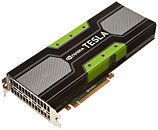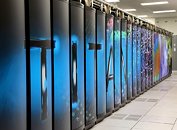- Joined
- Dec 6, 2011
- Messages
- 4,784 (1.01/day)
- Location
- Still on the East Side
NVIDIA today unveiled the NVIDIA Tesla K20 family of GPU accelerators, the highest performance, most efficient accelerators ever built, and the technology powering Titan, the world's fastest supercomputer according to the TOP500 list released this morning at the SC12 supercomputing conference.
Armed with 18,688 NVIDIA Tesla K20X GPU accelerators, the Titan supercomputer at Oak Ridge National Laboratory in Oak Ridge, Tenn. seized the No. 1 supercomputer ranking in the world from Lawrence Livermore National Laboratory's Sequoia system with a performance record of 17.59 petaflops as measured by the LINPACK benchmark.


Tesla K20 - Performance, Energy-Efficiency Leadership
Based on the revolutionary NVIDIA Kepler compute architecture, the new Tesla K20 family features the Tesla K20X accelerator, the flagship of NVIDIA's Tesla accelerated computing product line.
Providing the highest computing performance ever available in a single processor, the K20X provides tenfold application acceleration when paired with leading CPUs. It surpasses all other processors on two common measures of computational performance -- 3.95 teraflops single-precision and 1.31 teraflops double-precision peak floating point performance.
The new family also includes the Tesla K20 accelerator, which provides 3.52 teraflops of single-precision and 1.17 teraflops of double-precision peak performance. Tesla K20X and K20 GPU accelerators representing more than 30 petaflops of performance have already been delivered in the last 30 days. This is equivalent to the computational performance of last year's 10 fastest supercomputers combined.
"We are taking advantage of NVIDIA GPU architectures to significantly accelerate simulations in such diverse areas as climate and meteorology, seismology, astrophysics, fluid mechanics, materials science, and molecular biophysics," said Dr. Thomas Schulthess, professor of computational physics at ETH Zurich and director of the Swiss National Supercomputing Center. "The K20 family of accelerators represents a leap forward in computing compared to NVIDIA's prior Fermi architecture, enhancing productivity and enabling us potentially to achieve new insights that previously were impossible."
Additional early customers include: Clemson University, Indiana University, Thomas Jefferson National Accelerator Facility (Jefferson Lab), King Abdullah University of Science and Technology (KAUST), National Center for Supercomputing Applications (NCSA), National Oceanic and Atmospheric Administration (NOAA), Oak Ridge National Laboratory (ORNL), University of Southern California (USC), and Shanghai Jiao Tong University (SJTU).
Energy-Efficiency for "Greener" Data Centers
The Tesla K20X GPU accelerator delivers three times higher energy efficiency than previous-generation GPU accelerators and widens the efficiency advantage compared to CPUs.
Using Tesla K20X accelerators, Oak Ridge's Titan achieved 2,142.77 megaflops of performance per watt, which surpasses the energy efficiency of the No. 1 system on the most recent Green500 list of the world's most energy-efficient supercomputers.
Fastest on Broadest Range of Data Center Applications
The Tesla K20 family accelerates the broadest range of scientific, engineering and commercial high performance computing and data center applications. Today, more than 200 software applications take advantage of GPU-acceleration, representing a 60 percent increase in less than a year.
When Tesla K20X GPU accelerators are added to servers with Intel Sandy Bridge CPUs, many applications are accelerated up to 10x or more, including:
● MATLAB (engineering) - 18.1 times faster
● Chroma (physics) - 17.9 times faster
● SPECFEM3D (earth science) - 10.5 times faster
● AMBER (molecular dynamics) - 8.2 times faster
More information about the Tesla K20 GPU accelerators is available at NVIDIA booth 2217 at SC12, Nov. 12-15, and on the NVIDIA high performance computing website. Users can also try the Tesla K20 accelerator for free on remotely hosted clusters. Visit the GPU Test Drive website for more information.
View at TechPowerUp Main Site
Armed with 18,688 NVIDIA Tesla K20X GPU accelerators, the Titan supercomputer at Oak Ridge National Laboratory in Oak Ridge, Tenn. seized the No. 1 supercomputer ranking in the world from Lawrence Livermore National Laboratory's Sequoia system with a performance record of 17.59 petaflops as measured by the LINPACK benchmark.


Tesla K20 - Performance, Energy-Efficiency Leadership
Based on the revolutionary NVIDIA Kepler compute architecture, the new Tesla K20 family features the Tesla K20X accelerator, the flagship of NVIDIA's Tesla accelerated computing product line.
Providing the highest computing performance ever available in a single processor, the K20X provides tenfold application acceleration when paired with leading CPUs. It surpasses all other processors on two common measures of computational performance -- 3.95 teraflops single-precision and 1.31 teraflops double-precision peak floating point performance.
The new family also includes the Tesla K20 accelerator, which provides 3.52 teraflops of single-precision and 1.17 teraflops of double-precision peak performance. Tesla K20X and K20 GPU accelerators representing more than 30 petaflops of performance have already been delivered in the last 30 days. This is equivalent to the computational performance of last year's 10 fastest supercomputers combined.
"We are taking advantage of NVIDIA GPU architectures to significantly accelerate simulations in such diverse areas as climate and meteorology, seismology, astrophysics, fluid mechanics, materials science, and molecular biophysics," said Dr. Thomas Schulthess, professor of computational physics at ETH Zurich and director of the Swiss National Supercomputing Center. "The K20 family of accelerators represents a leap forward in computing compared to NVIDIA's prior Fermi architecture, enhancing productivity and enabling us potentially to achieve new insights that previously were impossible."
Additional early customers include: Clemson University, Indiana University, Thomas Jefferson National Accelerator Facility (Jefferson Lab), King Abdullah University of Science and Technology (KAUST), National Center for Supercomputing Applications (NCSA), National Oceanic and Atmospheric Administration (NOAA), Oak Ridge National Laboratory (ORNL), University of Southern California (USC), and Shanghai Jiao Tong University (SJTU).
Energy-Efficiency for "Greener" Data Centers
The Tesla K20X GPU accelerator delivers three times higher energy efficiency than previous-generation GPU accelerators and widens the efficiency advantage compared to CPUs.
Using Tesla K20X accelerators, Oak Ridge's Titan achieved 2,142.77 megaflops of performance per watt, which surpasses the energy efficiency of the No. 1 system on the most recent Green500 list of the world's most energy-efficient supercomputers.
Fastest on Broadest Range of Data Center Applications
The Tesla K20 family accelerates the broadest range of scientific, engineering and commercial high performance computing and data center applications. Today, more than 200 software applications take advantage of GPU-acceleration, representing a 60 percent increase in less than a year.
When Tesla K20X GPU accelerators are added to servers with Intel Sandy Bridge CPUs, many applications are accelerated up to 10x or more, including:
● MATLAB (engineering) - 18.1 times faster
● Chroma (physics) - 17.9 times faster
● SPECFEM3D (earth science) - 10.5 times faster
● AMBER (molecular dynamics) - 8.2 times faster
More information about the Tesla K20 GPU accelerators is available at NVIDIA booth 2217 at SC12, Nov. 12-15, and on the NVIDIA high performance computing website. Users can also try the Tesla K20 accelerator for free on remotely hosted clusters. Visit the GPU Test Drive website for more information.
View at TechPowerUp Main Site






